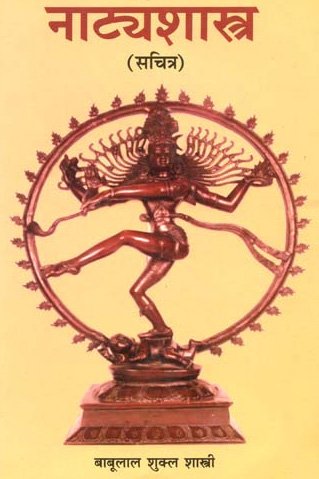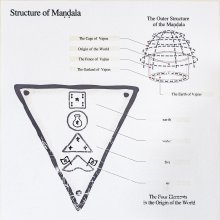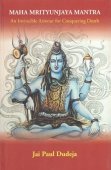Bhana, Bhāṇa, Bhāṅa: 23 definitions
Introduction:
Bhana means something in Buddhism, Pali, Hinduism, Sanskrit, Jainism, Prakrit, the history of ancient India, Marathi, Hindi. If you want to know the exact meaning, history, etymology or English translation of this term then check out the descriptions on this page. Add your comment or reference to a book if you want to contribute to this summary article.
Images (photo gallery)
In Hinduism
Natyashastra (theatrics and dramaturgy)
Source: Wisdom Library: Nāṭya-śāstraBhāṇa (भाण) refers to one of the “ten kinds of dramatic plays” (daśarūpa), according to the Nāṭyaśāstra chapter 20. These different types of dramas are considered to have originated from the various styles (vṛtti), which is discussed in chapter 22 of the same work. The Bhāṇa type of drama includes the following styles: Verbal (bhāratī), Grand (sāttvatī) and Energetic (ārabhaṭī).
Source: archive.org: Natya ShastraBhāṇa (भाण).—One of the ten types of play (nāṭya).—The Bhāṇa is an one Act play with a single character who speaks after repeating answers to his questions supposed to be given by a person who remains invisible, throughout. This play in monologue relates to one’s own or another’s adventure. It should always include many movements which are to be acted by a rogue or a Parasite.
The Prahasana, the Vīthi, the Aṅka and the Bhāṇa are the to have only two segments (sandhi) which should be the Opening (mukha) and the Conclusion (nirvahaṇa), and their Style (vṛtti) should be the Verbal one (bhāratī).
Source: Shodhganga: Elements of Art and Architecture in the Trtiyakhanda of the Visnudharmottarapurana (natya)Bhāṇa (भाण) refers to one of the twelve kinds of Rūpaka, which represents the dṛśyakāvya division of Kāvya (“poetry”), according to the Viṣṇudharmottarapurāṇa, an ancient Sanskrit text which (being encyclopedic in nature) deals with a variety of cultural topics such as arts, architecture, music, grammar and astronomy.—Bhāṇa is a one act drama and full of fights and it should be presented by only one actor who has to talk through speeches in air. The Nāṭyaśāstra has the same view point with the Viṣṇudharmottarapurāṇa in this matter. According to the Sāhityadarpaṇa, the one and only character of a bhāṇa is projected to be a cunning person.

Natyashastra (नाट्यशास्त्र, nāṭyaśāstra) refers to both the ancient Indian tradition (shastra) of performing arts, (natya—theatrics, drama, dance, music), as well as the name of a Sanskrit work dealing with these subjects. It also teaches the rules for composing Dramatic plays (nataka), construction and performance of Theater, and Poetic works (kavya).
Gitashastra (science of music)
Source: Shodhganga: Elements of Art and Architecture in the Trtiyakhanda of the Visnudharmottarapurana (gita)Bhāṇa (भाण) refers to a musical instrument classified as Avanaddha (“those instrument whose mouths are covered with leather (known as avanaddha)”) which represents one of the four kinds of Instrumental Music, produced by an instrument (ātodya), according to the Saṃgītaratnākara.—In the Viṣṇudharmottarapurāṇa and the Saṃgītaratnākara, some examples of avanaddha type of instruments are given, e.g., Bhāṇa.
Gitashastra (गीतशास्त्र, gītaśāstra) refers to the ancient Indian science of Music (gita or samgita), which is traditionally divided in Vocal music, Instrumental music and Dance (under the jurisdiction of music). The different elements and technical terms are explained in a wide range of (often Sanskrit) literature.
In Buddhism
Mahayana (major branch of Buddhism)
Source: Wisdom Library: Maha Prajnaparamita SastraBhāṇa (भाण) refers to “one’s voice” [?], according to Mahāprajñāpāramitāśāstra (chapter 19).—Accordingly, “Furthermore, some say that generosity is the cause and condition (hetupratyaya) for obtaining the thirty-two marks. Why is that? [...] When one agrees to give what the supplicant wants and if one expresses oneself delicately with gentleness in true words (satyavāda), without resorting to lying (mṛṣāvada), one obtains the marks consisting of having a broad tongue (prabhūta-jihvā), a Brahmic voice (brahmasvara) and a voice pleasant like that of the sparrow (kalaviṅka-bhāṇa). [...]”.

Mahayana (महायान, mahāyāna) is a major branch of Buddhism focusing on the path of a Bodhisattva (spiritual aspirants/ enlightened beings). Extant literature is vast and primarely composed in the Sanskrit language. There are many sūtras of which some of the earliest are the various Prajñāpāramitā sūtras.
In Jainism
General definition (in Jainism)
Source: academia.edu: Tessitori Collection IBhāṇa (भाण) is the name of an ancient king, according to the “Sumatisādhusūri nau vīvāhalau” (dealing with individual religious teachers in Jain literature), which is included in the collection of manuscripts at the ‘Vincenzo Joppi’ library, collected by Luigi Pio Tessitori during his visit to Rajasthan between 1914 and 1919.—[...] Later on, in Idar (north Gujarat, vs. 63) lived one Mahirāja Koṭhāri who was well-considered by the local ruler king Bhāṇa, and his wife Māṇikadevi (64-66). Their sons Śrīpāla and Sahajapāla and Śrīpāla’s wife Suhavadevī (67-68) gave wealth and requested Lakṣmīsāgarasūri to grant the status of Sūri to the monk. The ceremony was performed. Sumatisādhusūri thus became the (54th) head of the tapāgaccha as successor to Lakṣmīsāgarasūri. [...]

Jainism is an Indian religion of Dharma whose doctrine revolves around harmlessness (ahimsa) towards every living being. The two major branches (Digambara and Svetambara) of Jainism stimulate self-control (or, shramana, ‘self-reliance’) and spiritual development through a path of peace for the soul to progess to the ultimate goal.
India history and geography
Source: academic.ru: South Asian ArtsApart from the more seriously intended plays described above, the Sanskrit theatre also has a rich repertory of farces, which are usually in one act. Most interesting of these are the bhāṇas, which may be monologues in which an actor addresses imaginary persons and is answered by them, as he paints a picture of town life full of personal and social satire. Among the best in this little-studied genre is Śyāmilaka's 5th-century Pādataḍitaka (“The Courtesan's Kick”).

The history of India traces the identification of countries, villages, towns and other regions of India, as well as mythology, zoology, royal dynasties, rulers, tribes, local festivities and traditions and regional languages. Ancient India enjoyed religious freedom and encourages the path of Dharma, a concept common to Buddhism, Hinduism, and Jainism.
Languages of India and abroad
Pali-English dictionary
Source: Sutta: The Pali Text Society's Pali-English DictionaryBhāṇa, (fr. bhaṇati) reciting or preaching, in pada° reciting the verses of the Scriptures DhA. II, 95 (v. l. paṭibhāna); III, 345; IV, 18.

Pali is the language of the Tipiṭaka, which is the sacred canon of Theravāda Buddhism and contains much of the Buddha’s speech. Closeley related to Sanskrit, both languages are used interchangeably between religions.
Marathi-English dictionary
Source: DDSA: The Molesworth Marathi and English Dictionarybhāṇa (भाण).—m n S A species of dramatic composition. There are ten; viz. nāṭaka, samprakaraṇa, bhāṇa, prahasana, ḍimavyā, yōga, samavākāra, vītthī, aṅka, īhāmṛga.
--- OR ---
bhāna (भान).—n (S) Consciousness, waking or present state of the mental faculties. Ex. jvarāmuḷēṃ tyācēṃ bhāna gēlēṃ; tumhī gōṣṭa sāṅgitalī tēvhāṃ mī bhānāvara navha- tōṃ; nāhīṃ strīpuruṣabhāna || mītūpaṇa tēthēṃ kaiñcēṃ ||. 2 Attention, advertence, heed, notice, observation: also mindfulness or awareness; clear remembrance or mental perception. Ex. tē vēḷēsa tumhākaḍē mājhēṃ bhāna navhatēṃ; tumhāsīṃ bōlatāṃ bhōjanāsa jāṇyācēṃ bhāna rā- hilēṃ nāhīṃ. 3 Notion; representation formed in the mind; image or idea impressed; an impression. Ex. nagāṛyācē śabdāvarūna rājācī svārī cāla- lī asēṃ bhāna jhālēṃ.
--- OR ---
bhānā (भाना).—m A vessel of money secretly buried in the wall of a house.
Source: DDSA: The Aryabhusan school dictionary, Marathi-Englishbhāna (भान).—n Consciousness; mindfulness; attention; an impression.
Marathi is an Indo-European language having over 70 million native speakers people in (predominantly) Maharashtra India. Marathi, like many other Indo-Aryan languages, evolved from early forms of Prakrit, which itself is a subset of Sanskrit, one of the most ancient languages of the world.
Sanskrit dictionary
Source: DDSA: The practical Sanskrit-English dictionaryBhāṇa (भाण).—A species of dramatic composition; in it only one character is introduced on the stage which supplies the place of interlocutors by a copious use of आकाशभाषित (ākāśabhāṣita) q. v.; भाणः स्याद्धर्तचरितो नानावस्थान्तरा- त्मकः । एकाङ्क एक एवात्र निपुणः पण्डितो विटः (bhāṇaḥ syāddhartacarito nānāvasthāntarā- tmakaḥ | ekāṅka eka evātra nipuṇaḥ paṇḍito viṭaḥ) || S. D.513; see the next stanzas also; e. g. वसन्ततिलक, मुकुन्दानन्द, लीलामधुकर (vasantatilaka, mukundānanda, līlāmadhukara) &c.
Derivable forms: bhāṇaḥ (भाणः).
See also (synonyms): bhāṇikā.
--- OR ---
Bhāna (भान).—[bhā-bhāve lyuṭ]
1) Appearing, being visible.
2) Light, lustre.
3) Perception, knowledge.
Derivable forms: bhānam (भानम्).
Source: Cologne Digital Sanskrit Dictionaries: Edgerton Buddhist Hybrid Sanskrit DictionaryBhāna (भान).—(°-) (Index), or Bhāma- (text) -kanakamuni, Mahāvastu i.294.20, appears to be another designation of Kanaka- muni, q.v., unless the text is corrupt, which is probable.
Source: Cologne Digital Sanskrit Dictionaries: Shabda-Sagara Sanskrit-English DictionaryBhāṇa (भाण).—m.
(-ṇaḥ) A sort of dramatic entertainment, described as one, in which one only of the interlocutors appears on the scene; or as the narrative of some intrigue, told either by the hero or a third person. E. bhaṇ to speak, aff. ghañ .
--- OR ---
Bhāna (भान).—n.
(-naṃ) The act of growing visible. 2. Light, lustre. 3. Perception. E. bhā, lyuṭ aff.
Source: Cologne Digital Sanskrit Dictionaries: Benfey Sanskrit-English DictionaryBhāna (भान).—i. e. bhā + ana, n. 1. Appearance, [Vedāntasāra, (in my Chrestomathy.)] in
— Cf.
Source: Cologne Digital Sanskrit Dictionaries: Cappeller Sanskrit-English DictionaryBhaṇa (भण).—[masculine] telling (—°).
--- OR ---
Bhāṇa (भाण).—[masculine] a kind of drama.
--- OR ---
Bhāna (भान).—[neuter] = bhāti.
Source: Cologne Digital Sanskrit Dictionaries: Monier-Williams Sanskrit-English Dictionary1) Bhaṇa (भण):—[from bhaṇ] See dur-bhaṇa.
2) Bhāna (भान):—[from bhā] a n. appearance, evidence, perception, [Vedāntasāra; Bhāṣāpariccheda] etc.
3) [v.s. ...] light, lustre, [cf. Lexicographers, esp. such as amarasiṃha, halāyudha, hemacandra, etc.]
4) Bhāṇa (भाण):—m. (√bhaṇ) recitation ([especially] of the Buddhist law), [Monier-Williams’ Buddhism 44]
5) Name of a sort of dramatic entertainment (in which only one of the interlocutors appears on the scene, or a narrative of some intrigue told either by the hero or a third person), [Daśarūpa; Sāhitya-darpaṇa; Pratāparudrīya] (cf. [Indian Wisdom, by Sir M. Monier-Williams 471]).
6) Bhāna (भान):—b bhānu and e. See p. 751, col. 1.
Source: Cologne Digital Sanskrit Dictionaries: Yates Sanskrit-English DictionaryBhāṇa (भाण):—(ṇaḥ) 1. m. A one act comedy.
Source: DDSA: Paia-sadda-mahannavo; a comprehensive Prakrit Hindi dictionary (S)Bhaṇa (भण) in the Sanskrit language is related to the Prakrit word: Bhaṇaga.
[Sanskrit to German]
Sanskrit, also spelled संस्कृतम् (saṃskṛtam), is an ancient language of India commonly seen as the grandmother of the Indo-European language family (even English!). Closely allied with Prakrit and Pali, Sanskrit is more exhaustive in both grammar and terms and has the most extensive collection of literature in the world, greatly surpassing its sister-languages Greek and Latin.
Hindi dictionary
Source: DDSA: A practical Hindi-English dictionary1) Bhāna (भान) [Also spelled bhan]:—(nm) change (of smaller denomination); awareness; inkling; —[honā] to have an inkling of.
2) Bhānā (भाना):—(v) to be liked; to be agreeable, to be pleasing/appealing.
...
Prakrit-English dictionary
Source: DDSA: Paia-sadda-mahannavo; a comprehensive Prakrit Hindi dictionaryBhaṇa (भण) in the Prakrit language is related to the Sanskrit word: Bhaṇ.
Prakrit is an ancient language closely associated with both Pali and Sanskrit. Jain literature is often composed in this language or sub-dialects, such as the Agamas and their commentaries which are written in Ardhamagadhi and Maharashtri Prakrit. The earliest extant texts can be dated to as early as the 4th century BCE although core portions might be older.
Kannada-English dictionary
Source: Alar: Kannada-English corpusBhāṇa (ಭಾಣ):—[noun] a kind of drama or interlocution enacted by a single person having an imaginary incident of a thief, wicked fellow, etc., as a theme.
--- OR ---
Bhāna (ಭಾನ):—
1) [noun] the act or an instance of appearing; appearance.
2) [noun] the act of perceiving or the ability to perceive; mental grasp of objects, qualities, etc. by means of the senses; awareness; comprehension; perception.
3) [noun] the state of being conscious; awareness of one’s own feelings, what is happening around one, etc.; consciousness.
4) [noun] the act or power of recollecting or calling back to mind; remembrance.
5) [noun] light; lustre; brightness.
Kannada is a Dravidian language (as opposed to the Indo-European language family) mainly spoken in the southwestern region of India.
See also (Relevant definitions)
Starts with (+48): Bhana-major, Bhanaaki, Bhanabhana, Bhanabhanagudu, Bhanabhanam, Bhanabhanana, Bhanabhananem, Bhanabhanata, Bhanabhanaunu, Bhanabhanavinem, Bhanabhanita, Bhanabhanya, Bhanabhi, Bhanabhuja, Bhanabhuna, Bhanabhune, Bhanaga, Bhanagada, Bhanagadakhora, Bhanagadanem.
Ends with (+231): Abbhana, Abhana, Abhibhana, Abhilambhana, Agnistambhana, Agrabhana, Ahijambhana, Akkebhana, Akkhobhana, Akshayapratibhana, Alabhana, Alambhana, Ambalabhana, Ambhana, Amitradambhana, Anandatilakabhana, Anangajivanabhana, Anangamangalabhana, Anangasarvasvabhana, Anangavijayabhana.
Full-text (+148): Bhanika, Mukundananda, Bhanasthana, Prabhana, Durbhana, Bhanatas, Pradyumnananda, Bhan, Bhaṇita, Bhanaka, Shringarakosha, Bhana-major, Durbhanatva, Bhanavat, Pratibhanavattva, Nicumpanam, Vrishabhanu, Bhamakanakamuni, Mishrabhana, Bhaṇati.
Relevant text
Search found 30 books and stories containing Bhana, Bhāṇa, Bhānā, Bhāna, Bhaṇa, Bhāṅa; (plurals include: Bhanas, Bhāṇas, Bhānās, Bhānas, Bhaṇas, Bhāṅas). You can also click to the full overview containing English textual excerpts. Below are direct links for the most relevant articles:
Vishnudharmottara Purana (Art and Architecture) (by Bhagyashree Sarma)
1.4. Types of Drama < [Chapter 3 - Drama and Dance]
4. Instrumental Music (Vādya) < [Chapter 2 - Music]
Hanuman Nataka (critical study) (by Nurima Yeasmin)
Part 2: Varieties of Dṛśyakāvya < [Chapter 1]
Dasarupaka (critical study) (by Anuru Ranjan Mishra)
Part 3-6 - Bhāṇa rules < [Chapter 2 - Bhāṇa (critical study)]
Part 14 - Conclusion < [Chapter 2 - Bhāṇa (critical study)]
Introduction to the Bhāṇa type of Drama < [Chapter 2 - Bhāṇa (critical study)]
Satirical works of Kshemendra (study) (by Arpana Devi)
7. Prominent Satirical Works in Sanskrit < [Chapter 1 - Introduction]
7.4. Summary of the Pādatāḍitaka < [Chapter 1 - Introduction]
7.3. Summary of the Dhūrtaviṭasaṃvāda < [Chapter 1 - Introduction]
Dhammapada (Illustrated) (by Ven. Weagoda Sarada Maha Thero)
Verse 264-265 - The Story of Venerable Hatthaka < [Chapter 19 - Dhammaṭṭha Vagga (Established in Dhamma)]
Gati in Theory and Practice (by Dr. Sujatha Mohan)
Relevance of Gati in Rūpakas < [Chapter 3 - Application of gati in Dṛśya-kāvyas]
Gati performed in Lāsyāṅgas < [Chapter 3 - Application of gati in Dṛśya-kāvyas]
Importance of Gati in Uparūpakas < [Chapter 3 - Application of gati in Dṛśya-kāvyas]
Related products

